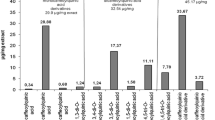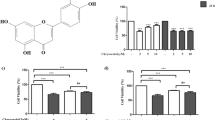Abstract
The Angelica decursiva has been used in Korean traditional medicine as an antitussive, an analgesic, an antipyretic and a cough remedy. However, its anti-tumor activity has been completely unknown. In this study, therefore, we have examined the cytotoxic activity of ethanol extract of Angelica decursiva root (EEAD), and the mechanism of cell death exhibited by EEAD in C6 rat glioma cells. Treatment of EEAD in C6 cells induced the apoptotic cell death in a concentrationand a time-dependent manner. Furthermore, the proteolytic processing of caspase-3, -7, and -9 was increased by EEAD treatment in C6 cells. In addition, activation of caspase-3 and -7 was detected in living C6 cells by fluorescence microscopy. These results suggest that EEAD can induce the suppression of cell growth and cell apoptosis in C6 rat glioma cells, and therefore, that it may have potential properties for anti-tumor drug discovery.
Similar content being viewed by others
Abbreviations
- EEAD:
-
ethanol extract of Angelica decursiva root
- MTT:
-
3-[4,5-dimethylthiazol-2-yl]-2,5-diphenyltetrazolium bromide
References
Ahn EM, Han JT, Kwon BM, Kim SH, and Baek NI (2008) Anti-cancer Activity of Flavonoids from Aceriphyllum rossii. J Korean Soc Appl Biol Chem 51, 309–315.
Capuani S, Gili T, Bozzali M, Russo S, Porcari P, Cametti C, D’Amore E, Colasanti M, Venturini G, Maraviglia B, Lazzarino G, and Pastore FS (2008) L-DOPA preloading increases the uptake of borophenylalanine in C6 glioma rat model: A new strategy to improve BNCT efficacy. Int J Radiat Oncol 72, 562–567.
Cheng YL, Lee SC, Lin SZ, Chang WL, Chen YL, Tsai NM, Liu YC, Tzao C, Yu DS, and Harn HJ (2005) Anti-proliferative activity of Bupleurum scrozonerifolium in A549 human lung cancer cells in vitro and in vivo. Cancer Lett 222, 183–193.
Chicca A, Adinolfi B, Martinotti E, Fogli S, Breschi MC, Pellati F, Benvenuti S, and Nieri P (2007) Cytotoxic effects of Echinacea root hexanic extracts on human cancer cell lines. J Ethnopharmacol 110, 148–153.
Christou L, Hatzimichael E, Chaidos A, Tsiara S, and Bourantas KL (2001) Treatment of plasma cell leukemia with vincristine, liposomal doxorubicin and dexamethasone. Eur J Haematol 67, 51–53.
Cohen GM (1997) Caspases: the executioners of apoptosis. Biochem J 326, 1–16.
Datta R, Kojima H, Yoshida K, and Kufe D (1997) Caspase-3-mediated cleavage of protein kinase C theta in induction of apoptosis. J Biol Chem 272, 20317–20320.
Green DR and Reed JC (1998) Mitochondria and apoptosis. Science 281, 1308–1312.
Hayashi K, Hibasami H, Murakami T, Terahara N, Mori M, and Tsukui A (2006) Induction of apoptosis in cultured human stomach cancer cells by potato anthocyanins and its inhibitory effects on growth of stomach cancer in mice. Food Sci Technol Res 12, 22–26.
Hengartner MO (2000) The biochemistry of apoptosis. Nature 407, 770–76.
Hoshino T, Hara A, Inoue M, Honda J, Imai Y, Oizumi K, and Yokoyama MM (1991) Flow cytometric measurement of NK cell cytotoxicity. J Clin Lab Immunol 36, 39–43.
Hostanska K, Jurgenliemk G, Abel G, Nahrstedt A, and Saller R (2007) Willow bark extract (BNO1455) and its fractions suppress growth and induce apoptosis in human colon and lung cancer cells. Cancer Detect Prev 31, 129–139.
Hu H, Ahn NS, Yang X, Lee YS, and Kang KS (2002) Ganoderma lucidum extract induces cell cycle arrest and apoptosis in MCF-7 human breast cancer cell. Int J Cancer 102, 250–253.
Hu W and Kavanagh JJ (2003) Anticancer therapy targeting the apoptotic pathway. Lancet Oncol 4, 721–729.
Kaufmann SH and Earnshaw WC (2000) Induction of apoptosis by cancer chemotherapy. Exp Cell Res 256, 42–49.
Kaufmann SH and Hengartner MO (2001) Programmed cell death: alive and well in the new millennium. Trends Cell Biol 11, 526–534.
Kim DK, Kim IJ, Hwang S, Kook JH, Lee MC, Shin BA, Bae CS, Yoon JH, Ahn SG, Kim SA, Kanai Y, Endou H, and Kim JK (2004) System L-amino acid transporters are differently expressed in rat astrocyte and C6 glioma cells. Neurosci Res 50, 437–446.
Kim JY, Kim HS, Kang HS, Choi JS, Yokozawa T, and Chung HY (2008) Antioxidant potential of dimethyl lithospermate isolated from Salvia miltiorrhiza (red sage) against peroxynitrite. J Med Food 11, 21–28.
Lee SM, Li ML, Tse YC, Leung SC, Lee MM, and Tsui SK (2002) Paeoniae Radix, a chinese herbal extract, inhibit hepatoma cells growth by inducing apoptosis in a p53 independent pathway. Life Sci 71, 2267–2277.
Liu X, Zou H, Slaughter C, and Wang X (1997) DFF, a heterodimeric protein that functions downstream of caspase-3 to trigger DNA fragmentation during apoptosis. Cell 89, 175–184.
Mukherjee AK, Basu S, Sarkar N, and Ghosh AC (2001) Advances in cancer therapy with plant based natural products. Curr Med Chem 8, 1467–1486.
Park DI, Lee JH, Moon SK, Kim CH, Lee YT, Cheong J, Choi BT, and Choi YH (2005) Induction of apoptosis and inhibition of telomerase activity by aqueous extract from Platycodon grandiforum in human lung carcinama cells. Pharmacol Res 51, 437–443.
Park SK, Lee CW, and Lee MY (2008) Inhibitory Effect of Ore Minerals on the Allergic Inflammation in Mouse. J Korean Soc Appl Biol Chem 51, 269–275.
Paschka AG, Butler R, and Young CYF (1998) Induction of apoptosis in prostate cancer cell lines by the green tea component, (-)-epigallocatechin-3-gallate. Cancer Lett 130, 1–7.
Pezutto JM (1997) Plant-derived anticancer agents. Biochem Pharmacol 53, 121–133.
Reed JC (2001) Apoptosis-regulating proteins as targets for drug discovery. Trends Mol Med 7, 314–319.
Smets LA (1994) Programmed cell death (apoptosis) and response to anti-cancer drugs. Anti-Cancer Drug 5, 3–9.
Stewart LA (2002) Chemotherapy in adult high-grade glioma: a systematic review and meta-analysis of individual patient data from 12 randomised trials. Lancet 359, 1011–1018.
Tan ML, Suaiman SF, Najimuddin N, Smian MR, and Tengku Muhammad TS (2005) Methanolic extract of Pereskia bleo (Kunth) DC. (Cactaceae) induces apoptosis in breast carcinama, T47-D cell line. J Ethnopharmacol 96, 287–294.
Tian Z, Chen S, Zhang Y, Huang M, Shi L, Huang F, Fong C, Yang M, and Xiao P (2006) The cytotoxicity of naturally occurring styryl lactones. Phytomedicine 13, 181–186.
van Poppel G and van den Berg H (1997) Vitamins and cancer. Cancer Lett 114, 195–202.
Yang HL, Chang WH, Chia YC, Huang CJ, Lu FJ, Hsu HK, and Hseu YC (2006) Toona sinensis extracts induces apoptosis via reactive oxygen species in human premyelocytic leukemia cells. Food Chem Toxicol 44, 1978–1988.
Author information
Authors and Affiliations
Corresponding author
Additional information
These authors contributed to this study equally.
Rights and permissions
About this article
Cite this article
Cho, SH., Kim, D.K., Kim, C.S. et al. Induction of apoptosis by Angelica decursiva extract is associated with the activation of caspases in glioma cells. J. Korean Soc. Appl. Biol. Chem. 52, 241–246 (2009). https://doi.org/10.3839/jksabc.2009.043
Received:
Accepted:
Issue Date:
DOI: https://doi.org/10.3839/jksabc.2009.043




